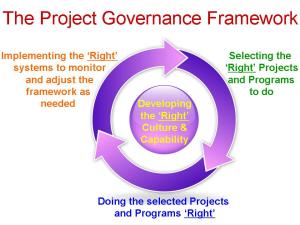A significant gap in the current standardisation of project, program and portfolio management relates to the senior management functions necessary to effectively manage the projects and programs initiated by the organisation.
Project Management, as defined by PMI, ISO21500 and a range of other standards commences when the project is funded, and concludes on the delivery of the outputs the project was established to deliver.
Program Management focuses on the coordinated management of a number of projects to achieve benefits that would not be available if the projects were managed in isolation. Different types of program have been defined by GAPPS ranging from optimising annual budgets to maintain a capability (eg, the maintenance of a railway system) through to creating a major change in the way an organisation operates.
Processes for identifying the best projects and programs for an organisation to invest in through portfolio management and tracking benefits realisation are also well defined within the context of strategic management, but are generally not as well implemented by organisations.
Finally the overall governance of organisations and its key sub-set, project governance is recognised as essential for the long term wellbeing of the organisation.
Within this overall framework, the element not well defined, that is essential to achieving the optimum benefits from the ‘doing of projects and programs’, is the organisation’s ability to manage the management of its projects and programs.
At the overall organisational level, the management of project management includes developing and supporting the capabilities needed to provide executive oversight and leadership so that the organisation is able to undertake projects and programs effectively. This includes the organisations ability to develop and enhance its overall project management capabilities, develop project and program managers and project team members, implement appropriate methodologies, provide effective sponsorship, and achieve the benefits and value the projects and programs were set up to facilitate.
At the individual department level, the ability to manage multiple projects in an effective way is equally critical. Typically the role of a Project Director, multi-project management differs from program management in a number of key aspects:
- There is limited correlation between the objectives of the various projects, eg a number of design and fabrication projects may each have a different external customer.
- The function is relatively stable and permanent (programs close once their objectives are achieved).
- The primary focus of this management function is resource optimisation, minimising conflicts and process clashes, and developing the project/program delivery capability of the department/facility.
A number of recognised roles such as the Project/Program Sponsor, project governance and PMOs contribute to the organisations ability to manage the management of projects and programs and develop effective multi-project management capabilities, what is missing is an overall framework that supports the ongoing development of these functions to facilitate the effective governance of projects, programs and portfolios.
Peter Morris and Joana Geraldi have recently published a paper focused on ‘Managing the Institutional Context for Projects’ (Project Management Journal, Vol.42, No.6 p20-32), this paper defines three levels of project management:
Level 1 – Technical ‘project management’; the processes defined in standards such as the PMBOK® Guide and ISO21500.
Level 2 – Strategic ‘management of projects’; the overall management of the project from concept to benefits realisation, starting with identifying and validating concepts, through portfolio selection to delivery and the creation of the intended value.
Level 3 – Institutional context; developing an institutional context for projects and programs to enable them to succeed and enhance their effectiveness. The focus is on creating an environment that encourages improved levels of success in all of the organisation’s projects and programs.
The theoretical framework described in Morris’ paper covers the same concepts (but from a different viewpoint) to the technical framework of organisational entities and roles defined in our White Paper, a PPP Taxonomy (and the linked White Papers focused on specific elements of the structure), see: http://www.mosaicprojects.com.au/WhitePapers/WP1074_PPP_Taxonomy.pdf
What developing the PPP Taxonomy identified within our White Papers, and Morris highlights in his paper, is the critical need for organisations to develop an intrinsic capability to manage the overall management of projects and programs. Over the next few weeks I hope to complete two additional White Papers to start filling this gap:
– The Management of Project Management – the institutional context.
– Multi-project Management – the departmental context.
In the meantime, a PPP Taxonomy defines the overall project governance and control framework these two critically important elements fit within.
On reflection, many of the project and program failures identified in our earlier posts as generic ‘governance failures’ are likely to be shown to be directly caused by the absence of systems designed to ‘manage project management’, this is still a governance failure but now the root cause of some of these failures may be able to be specifically defined.
This is an emerging area of thinking, you are invited to download the White Papers and post any thoughts, comments or disagreements, as well as make use of the ideas to help improve your organisations. There’s a long way to go, at present there’s not even a clearly defined term for this aspect of project governance/management……







